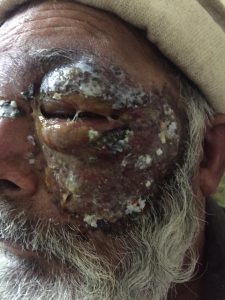Shingles also called as herpes zoster is a virus born disease, characterized by a rash and neuritis in a dermatomal pattern.
What causes shingles?
Shingles is caused by the virus varicella zoster which is responsible for the highly contagious disease Chickenpox. Chickenpox is the primary infection after which the virus remains dormant for years in the sensory ganglions of the nerves. The virus reactivates at some point in life causing shingles.
Which patients are prone to get shingles?
The virus varicella zoster can reactivate in any patient, however, the following groups of patients are especially at risk of reactivation of the virus:

- Elderly patients
- Patients with AIDS (Acquired Immunodeficiency syndrome)
- Patients with haematological diseases like aplastic anaemia, leukaemia, lymphoma and those who had a bone marrow transplant
- Diabetic patients
- Patients on steroids (especially a daily dose greater than 20 mg/day)
- Patients with cancers
How does Shingles (herpes zoster) present?
Shingles involve the skin in a dermatomal pattern. A dermatome is an area supplied by a single sensory nerve. Patients develop a rash which is a red, painful, vesicular or fluid-filled eruption in a specific area involving only one side of the body.

Occasionally, patients who are immunocompromised may develop herpes zoster of multiple areas of the body. In some patients, the rash may contain blood instead of clear fluid. It may also get infected and pus collection in the vesicles may be noted. Frank cellulitis and abscess formation may be seen if not treated promptly.
Acute neuritis:
The rash of shingles is commonly associated with severe pain in that specific area of the skin. The pain is described as burning, throbbing, stabbing and shooting in character. It may be misdiagnosed as a Myocardial infarction (heart attack), Renal colic and pneumonia if the pain precedes the rash.
What are the complications of Shingle’s herpes zoster?
Patients can develop any of the following complications depending on the area involved.
- Post-herpetic neuralgia: This is the persistent pain, numbness, paraesthesias, and/ or burning sensations in the area where the rash had appeared.
- Herpes Zoster Ophthalmicus: The fifth cranial nerve has three branches (the maxillary, mandibular and the ophthalmic). Somehow, the ophthalmic nerve is affected more and the rash appears on the forehead and upper eyelid. The vision may be affected and corneal ulceration or orbital cellulitis may further complicate the disease.
- Ramsy-Hunt syndrome: This is also called as herpes zoster oticus. The classic triad of herpes zoster oticus is facial paralysis, ear pain and a rash of the side affected. Patients may develop an abnormal taste sensation, hearing impairment, ringing sensation in the ears, imbalance, abnormal tear production and dizziness.
- Other complications: These include aseptic meningitis, acute retinal necrosis, peripheral motor neuropathy, myelitis, encephalitis, stroke, Guillain Barre syndrome and superimposed bacterial infections.
How is shingles treated?
Treatment aims to control the infection by giving antivirals (acyclovir, valacyclovir and famciclovir) and controlling the pain by giving pain medicines (NSAIDS), pregabalin and tricyclic antidepressants.
A detailed discussion on how to treat shingles will follow in the coming posts.
Is Shingles contagious?
Yes. Shingles can infect a person who is not vaccinated and comes in direct contact with the rash. Vaccinated individuals may develop chickenpox after coming into direct contact with the rash especially if they are immunocompromised, diabetic or aged.
How is shingles prevented?
Shingles vaccine is available and provides immunity lasting for two years. It is available by the name of VARIVAC, VARILRIX, OKAVAX and VAXAPOX.
Read More …
- WHO vaccination schedule for children
- CDC vaccination schedule for adults
- An elderly male with fever and facial lesions
- Allergic asthma – all that wheezes is not asthma
- Lose weight without diet and medicine